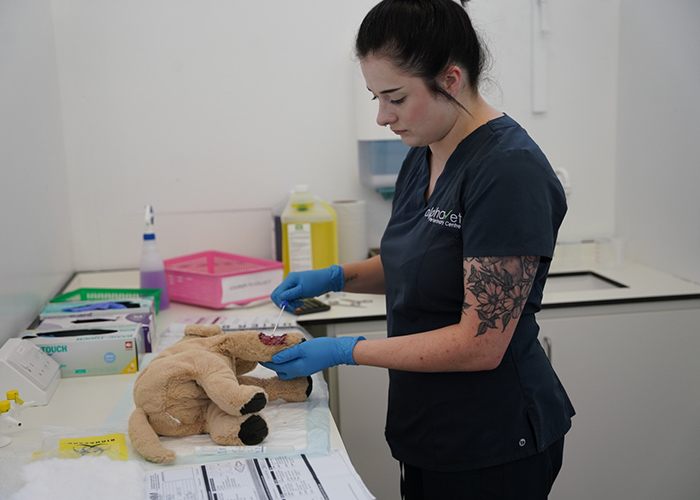Sector report
Work-based learning
2022-2023
Click on individual markers for provider details
Providers
10
Number of providers 2023
10
Number of providers 2022
17
Number of providers 2021
Learners
39,370
No. of apprenticeship learners 2021-2022
46,040
No. of apprenticeship learners 2020-21
15,635
No. of foundation apprenticeship learners 2021-2022
16,395
Apprenticeship level 3 learners 2021-22
7,340
Higher apprenticeship learners 2021-22
Core inspections
No. of core inspections: 3
Welsh-medium: 0
English-medium: 3
Case studies
No. of case studies: 3
Useful links
View the sector summary
Read an overview of inspection recommendations
Access reflective questions for the sector
Read about effective practice from the sector
Apprenticeship providers have worked well to sustain learners’ engagement with their programmes during the time since the outbreak of the COVID-19 pandemic. Despite this, a few learners took too long to complete their programmes. Overall, providers took good care of learners’ well-being and support their individual learning needs. However, providers were not supporting learners well enough to develop their literacy and numeracy skills, Welsh language ability and their understanding of radicalisation and extremism.

Teaching and learning
During 2022-2023, inspectors found that all three apprenticeship providers inspected had worked well to support learners to remain on-programme and to recruit new entrants to apprenticeship programmes following the disruption of the COVID-19 pandemic. As a result, many learners made sound progress in developing their theory knowledge and practical skills. However, a few learners who had been on-programme since the height of the pandemic had not made as much progress as they could. These learners often remained on-programme well beyond their expected apprenticeship completion dates, especially those apprentices in the health and social care sectors. This was mainly a consequence of the disruptive effects of the pandemic leading to assessors being unable to physically access care settings for extended periods. Other factors included the significant workforce pressures in these sectors and the introduction of new qualifications for these sectors. Although learner outcomes were beginning to improve, each of the three inspections resulted in a recommendation to improve the success and timely completion rates of learners in underperforming learning areas.
At each of the three providers, inspectors found that most learners made strong progress in their job roles, developing a wide range of specific vocational skills. Learners also developed highly valuable broader work-skills including effective communication with senior colleagues, peers and customers. As a result, apprentices were able to make strong contributions to their employers’ businesses and recognised the benefits of these improvements in their skills. In a few cases, employers were reluctant to release learners to attend off-the job or online sessions, especially Essential Skills Wales activities.
The majority of teachers, trainers and assessors had high expectations of their learners, encouraging and supporting them to complete written and practical assessments. In these cases, they thoughtfully planned activities that built well on previous learning and assessment. They supported learners in an individualised way, often visiting the learner’s workplace to undertake assessment and give personal support tailored to learners’ individual needs. Assessors monitored learners’ progress regularly, updated learner progress tracking documentation, and, in the best cases, set agreed and challenging targets for the completion of written work or practical assessments. Most learners knew the progress they were making and what they needed to do next, although the majority did not know their literacy, numeracy and digital skills targets. Teachers, trainers and assessors provided learners with helpful written feedback, which in the best cases was constructive and detailed and helped learners to improve their performance. In the best cases, providers had developed and used a comprehensive range of teaching and learning resources well to support progress, for example, see the case study about Educ8’s development of an effective virtual learning environment.
In both on and off-the-job sessions, many learners demonstrated effective listening skills. They took part enthusiastically in activities, especially practical sessions. Teachers, trainers and assessors used beneficial questioning techniques in most sessions. However, in a few instances, questioning was not used well enough to check learners’ knowledge or to probe higher level understanding. Tutors and assessors did not successfully engage learners in activities to develop their understanding of radicalisation and extremism well enough.
Many providers and subcontractors had begun to develop a range of bilingual teaching and learning resources and made progress in recognising and increasing the capacity of their staff members to deliver bilingually. However, the number of learners who chose to complete written aspects of their work in Welsh remained low. Learners with a high level of fluency did converse freely in Welsh with any Welsh speaking assessors or tutors to which they had access.

Care, support and well-being
The care, support and guidance made available to apprenticeship learners was significantly strengthened during and following the pandemic. All three providers inspected had robust arrangements for identifying learners who required additional support. This support was often focused on learners’ well-being and most staff members had developed their skills to enable them give meaningful initial support. This personal support effectively helped learners who were at risk of leaving their apprenticeships. Although these learners remained in-training they were, overall, taking much longer than planned to complete their apprenticeship frameworks.
Each of the three providers either had their own in-house support services, or access to external support agencies, to give specialist support to individual learners when a need was identified. These services included help with personal, financial and wellbeing issues. A particular strength of the providers was the personal support that assessors, as the first point of contact, provided to learners. The mutual trust and respect that developed as part of productive relationships between learners and assessors meant that assessors could sensitively help learners with a wide range of well-being needs. This ultimately supported learners to make progress in their vocational studies and their job roles. Most learners were motivated and enthusiastic about their learning with the majority planning to progress to the next level. These learners excelled in their workplaces and quickly became productive and valued members of their employers’ staff.
Inspectors found that the three providers inspected had strengthened their processes to identify learners’ support needs in a timely way, as a result, most learners accessed the support they needed quickly. This resulted in an increase in the number of learners who stated that they had an additional learning need. In the wake of the pandemic, the providers had identified an increasing trend in the number of learners who needed support with confidence and anxiety issues. This need was particularly acute during periods of external examinations and other important assessments. It was also notable that the proportion of level 3 learners who proactively took responsibility for their learning was lower than the pre-pandemic norm. These learners were more likely than in the past to need reassurance and support when collecting assessment evidence, completing written work or preparing for external assessments.
Inspectors found that providers supported their staff members well, enabling them to develop their own skills and abilities in supporting learners. Specialist training was used to enhance the support available to learners. Increasingly, providers were expanding the range of support available to apprentices. As part of the Grŵp Llandrillo Menai inspection, the provider was asked to produce a case study about their effective wrap around support and parity of access for learners across the group. Apprentices could access support and facilities across different sites, such as learning resource centres, gyms and counselling facilities.
All three providers had suitable arrangements and training in place to safeguard their learners, and staff at all levels understood their relevant roles and responsibilities. Learners had an appropriate understanding of safeguarding and knew whom to report incidents to, both in the workplace and with the provider. However, teachers, trainers and assessors did not engage learners in activities to develop their understanding of radicalisation and extremism well enough.

Leading and improving
The leaders of the three providers inspected supported the development of effective working relationships with partners, sub-contractors and local employers. Their strategic planning was aligned well to local, regional and national targets. Strong and well-established partnership working was underpinned by clear and regular communication between managers and staff members at all levels. Partners shared a wide range of useful information relating to the delivery of their apprenticeship contracts. In the best cases, headline learner progress and outcomes data were openly shared with partners and sub-contractors. This facilitated the evaluation of performance across each provider within the partnership. In these cases, effective practice was recognised and shared. Each of the three providers inspected placed a high value on professional learning for their staff members. In the best cases, this was shared with partners and sub-contractors and had resulted in staff being supported well to improve their delivery and assessment methods. In the Grŵp Llandrillo Menai inspection, a case study was identified that explained how the provider had developed inclusive professional learning opportunities for its own and its sub-contractor staff members.
All providers had comprehensive arrangements in place to self-evaluate and report on the quality of their work. Most providers were returning to the full range of pre-pandemic self-evaluation activities including the observation of teaching, training and assessment across their provision. However, improvement plans and targets did not always focus sharply enough on key areas for improvement such as supporting learners who were beyond the expected completion date for their apprenticeship.
Partly due to the pandemic, recruiting qualified and experienced assessors had become more challenging for apprenticeship providers. To ease this pressure, providers made appropriate use of various strategies, including improving conditions of service and recruiting experienced vocational specialists before training and supporting them to become qualified assessors. UK-wide challenges in the health and social care sector continued to be the cause of a major pressure point for providers. Learner recruitment, retention, and completion of apprenticeship frameworks within the expected timeframe were key concerns for the sector. Surprisingly, across the network of apprenticeship delivery providers, the enrolment of construction, planning and the built environment learners remained below target. This was at a time when the sector was buoyant and the need for apprentices across all trades was high. Across the majority of other learning areas, providers were attracting sufficient numbers of learners to meet demand. Most providers had strong working relationships with employers that they had often worked with for many years. The Skills Academy Wales case study describes the provider’s strong focus on anticipating labour market developments and proactive early engagement to meet the workforce needs of regional projects.
However, across the regions there remained a substantial number of employers who were not taking advantage of opportunities to have apprentice employees. Overall, training providers needed to do more to raise awareness of the benefits of apprenticeships and engage these employers.
The changes in Wales to qualifications in the health and social care, childcare and construction and built environment sectors had put increased pressure on learner recruitment. The new qualifications generally require learners to remain enrolled on programme for a longer time than they would under the previous arrangements. In addition, practical and theory work must be completed at a higher level. Concerns about the cost-of-living crisis and the rates that apprentices are paid were also contributing factors to the recruitment challenges. Providers reported that potential apprentices chose to take jobs that initially offered higher rates of pay but lacked formal training or better long-term career prospects.